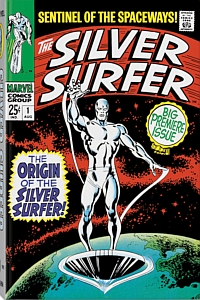Marvel invented many great and impressive superheroes. Some were allowed their own comic book series; some ran for years or even decades.
Compared to other Marvel characters and exclusive series, the Silver Surfer, main actor of the XXL title at hand, archived legendary status after a very short (comic book) lifetime. He was around for hardly two years and still is popular and well-remembered.
 As so often the case with Marvel‘s success stories, Stan Lee and in this case master artist Jack Kirby developed the Silver Surfer by applying the „Marvel Method.“
As so often the case with Marvel‘s success stories, Stan Lee and in this case master artist Jack Kirby developed the Silver Surfer by applying the „Marvel Method.“
Lee wrote a few vague story paragraphs of what should happen in vols. 48-50 of The Fantastic Four series, working title “Galactus Trilogy.” Kirby should develop the story with his own ideas, and he had a vision of the Silver Surfer for issue 48, of March 1966.
 A creature, simultaneously messenger and slave to planet-devouring Galactus, a giant evil super-life form ready to destroy Earth. The Silver Surfer, upon his arrival ready to prepare the planet for destruction, finally is convinced by The Fantastic Four and others to change sides.
A creature, simultaneously messenger and slave to planet-devouring Galactus, a giant evil super-life form ready to destroy Earth. The Silver Surfer, upon his arrival ready to prepare the planet for destruction, finally is convinced by The Fantastic Four and others to change sides.
He ends up protecting the planet and thus quickly reappeared in various Marvel series: Tales to Astonish and Fantastic Four Annual, before Lee initiated a series devoted exclusively to the new superhero in August 1968.
T his was the beginning of a new type of comic book, as this bi-monthly series offered 68 pages: some 40 devoted to the Silver Surfer plus a backup story.
his was the beginning of a new type of comic book, as this bi-monthly series offered 68 pages: some 40 devoted to the Silver Surfer plus a backup story.
Those extras also made the volumes a bit pricey, it cost 25 cents; the normal issues went for 12 cents. This experiment was over with volume 8, that hit newsstands again as the smaller, 15-cent version.
With this series, John Buscema (1927–2002), already celebrated for penciling The Avengers, Conan the Barbarian, The Sub-Mariner and The Fantastic Four, took over from Kirby and almost exclusively delivered all future and highly elegant Silver Surfer panels (except for #18, when Jack Kirby stepped in at short notice).
John’s brother, Sal Buscema is equally famous for first inking John’s drawings, and then went on to design The Incredible Hulk, The Defenders, Thor, and Spider-Girl. He provides a foreword to this volume.
The Silver Surfer series took off like a rocket; it quickly generated a lot of fans. But not due to the Surfer’s power, speed or ability to combat countless enemies simultaneously: instead, his role and character were basically rather those of the thinker, the introverted person, a tragic hero.
At that time, it hit a nerve with readers. As those characteristics were very much what the zeitgeist provided: musing about the meaning of life, the character of mankind, the human sacrifice in wars and how a single mind could cope with all that.
Alienation became one of his trademarks. It made him a role model for many readers, it seems, particularly those who were in their late teenage years. This may also have to do with the fact that the Surfer, like them, was unable to leave Earth, as Galactus had confined him there and a force field around the planet would stop him from ever leaving.
However, even such a thoughtful philosopher who often indulged into monologue and lengthy discourse with himself, was not fit for survival, it seems. A chaotic and hardly satisfying volume 18 ended the Silver Surfer‘s own series in 1970. (Only The Incredible Hulk had a shorter run at with the publisher in the1960s, with just six issues).
 As Stan Lee in a Marvel “Soapbox” (editorial space) explained, there were reasons. Although the concept and “… the Surfer was one of our biggest successes from the standpoint of reader acceptance. … Truly, we had succeeded in our goal - we had created a comic book for the older reader, for the more literate, more perceptive, more cognizant fan. But, in so doing, the Surfer’s exploits were too far over the heads of many of our younger readers, and for that reason, we lost a great many sales, since no comic magazine can be financially successful unless it sells to young and old alike.” Audiences had to wait until 1987 to hear more stories about that superhero.
As Stan Lee in a Marvel “Soapbox” (editorial space) explained, there were reasons. Although the concept and “… the Surfer was one of our biggest successes from the standpoint of reader acceptance. … Truly, we had succeeded in our goal - we had created a comic book for the older reader, for the more literate, more perceptive, more cognizant fan. But, in so doing, the Surfer’s exploits were too far over the heads of many of our younger readers, and for that reason, we lost a great many sales, since no comic magazine can be financially successful unless it sells to young and old alike.” Audiences had to wait until 1987 to hear more stories about that superhero.
 Until then, popular culture kept him and his style alive easily. For some audiences, this may also be related to certain methods of extreme fandom applied to certain artists, mostly actors or musicians, who passed away much too young and left but a few films or albums; although we never learn of the Silver Surfer’s real age. In popular culture this is referred to as the “27 Club.” What followed, was usually a massive cult that basically was fueled by the many possibilities and imaginings of what this person may have accomplished, if only he or she had been around a bit longer.
Until then, popular culture kept him and his style alive easily. For some audiences, this may also be related to certain methods of extreme fandom applied to certain artists, mostly actors or musicians, who passed away much too young and left but a few films or albums; although we never learn of the Silver Surfer’s real age. In popular culture this is referred to as the “27 Club.” What followed, was usually a massive cult that basically was fueled by the many possibilities and imaginings of what this person may have accomplished, if only he or she had been around a bit longer.
“He became a symbol of lonesome cool, an icon for those in the know. The musicians Brinsley Schwarz, Marc Bolan and T. Rex, Shakin’ Stevens, Utopia, and Arthur Brown’s Kingdom Come all name-dropped the Silver Surfer in ’70s lyrics, and Pink Floyd tried to include him on the sleeve of The Dark Side of the Moon. Ad Rock of the Beastie Boys sported a shoulder tattoo of the Surfer in the early ’80s” explains Douglas Wolk, who wrote the excellent 30 page introduction to this title. He is the author of “Reading Comics” and “All of the Marvels.” Yes, a title about… Marvel comics. His articles and features are published in The Believer, The New York Times, Time, and Rolling Stone, they cover popular culture and comic book art.
 All the tales, lore and internal fights, discussions, ideas and details at Marvel that started and ended the great story of the Silver Surfer can be found right here. As it is typical for the Taschen Marvel Comics Library, the complete output of this comic book superhero comes to your study or coffee table in XXL size.
All the tales, lore and internal fights, discussions, ideas and details at Marvel that started and ended the great story of the Silver Surfer can be found right here. As it is typical for the Taschen Marvel Comics Library, the complete output of this comic book superhero comes to your study or coffee table in XXL size.
Each and every page of the full series on special “old-school” paper, especially produced for this occasion. Only the most pristine original comics were photographed and digitally remastered for reproduction in cooperation with Marvel and the Certified Guaranty Company.
 Besides the many sketches, original drawings, first drafts, alternate covers and artworks of the series, the annex lists inkers, pencilers, letterers, memorabilia related to the Silver Surfer and a synopsis of all the story arcs in the 18 volumes. There are two versions of this heavy gem in English only, the Edition of 1,000 (1,000 pieces) and the Famous First Edition (5,000 pieces).
Besides the many sketches, original drawings, first drafts, alternate covers and artworks of the series, the annex lists inkers, pencilers, letterers, memorabilia related to the Silver Surfer and a synopsis of all the story arcs in the 18 volumes. There are two versions of this heavy gem in English only, the Edition of 1,000 (1,000 pieces) and the Famous First Edition (5,000 pieces).
A fine volume, devoted to probably the coolest and most alienated superhero of the Marvel Universe.
Review by Dr. A. Ebert © 2023
Marvel Comics Library. Silver Surfer. Vol. 1. 1968–1970 by Stan Lee, John Buscema, Douglas Wolk. Famous First Edition: First printing of 5,000 numbered copies. 11.0 x 15.6 in., 10.48 lb, 706 p., ISBN 978-3-8365-9651-0
Marvel Comics Library. Silver Surfer. Vol. 1. 1968–1970 by Stan Lee, John Buscema, Douglas Wolk. Edition of 1,000, Aluminum print cover tipped into a leatherette-bound spine, foil embossing, and housed in a slipcase, 11.0 x 15.6 in., 11.01 lb, 706 p., ISBN 978-3-8365-9221-5




